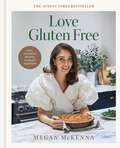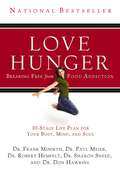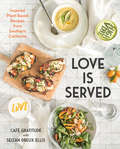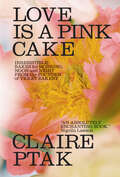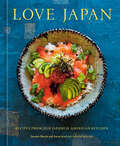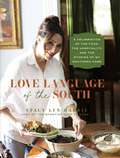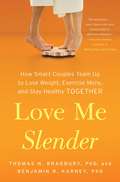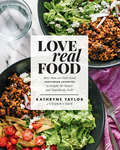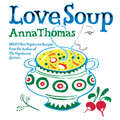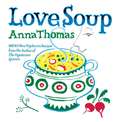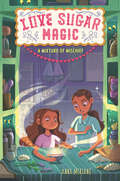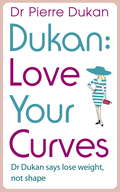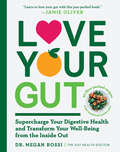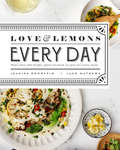- Table View
- List View
Love Gluten Free: Easy, delicious recipes to enjoy together
by Megan McKenna'I really hope you love making the recipes in this book as much as I do. So get your apron on, light a few candles, pour a glass of wine or fizz and get yourself in that kitchen. Gluten-free people can eat good food too, and this is proof!'An empowering and joyful new cookbook that shows how eating gluten-free has never been easier - or more delicious. In her new book, TV personality and Celebrity Masterchef finalist Megan McKenna is determined to re-define gluten free cooking, sharing 80 delicious recipes that spark joy for her and that are perfect for enjoying with loved ones, regardless of dietary requirements.Crowd-pleasing brunch recipes such as Baked Feta Bruschetta, Fluffy Pancakes with Bacon, Berries & Maple and Egg, Spinach and Feta muffinsRomantic date night dishes such as Megan's take on Marry-me Chicken, Pink Sauce spaghetti with Lardons & Walnuts and Mini Heart PizzasDelicious home comforts such as Short Rib Ragu of Dreams, Three-Cheese Crispy Mac & Cheese and Steak PieFun and tasty sharing plates (perfect for a celebration) such as Buffalo Chicken Bites, Barbecue Pulled Pork with Pineapple & Mini Tacos and Cider Battered FishFakeaways such as Hoisin Duck Summer Rolls, Egg Fried Rice and McK Apple PiesSince her coeliac diagnosis as a child and with a total social media following of 4.5 million, Megan McKenna speaks for a generation who are keen to create tasty recipes that are accessible for everyone, so there is no need to make a separate portion of gluten-free food when friends and family gather together to enjoy a delicious homecooked meal.
Love Gluten Free: Easy, delicious recipes to enjoy together
by Megan McKenna'I really hope you love making the recipes in this book as much as I do. So get your apron on, light a few candles, pour a glass of wine or fizz and get yourself in that kitchen. Gluten-free people can eat good food too, and this is proof!'An empowering and joyful new cookbook that shows how eating gluten-free has never been easier - or more delicious. In her new book, TV personality and Celebrity Masterchef finalist Megan McKenna is determined to re-define gluten free cooking, sharing 80 delicious recipes that spark joy for her and that are perfect for enjoying with loved ones, regardless of dietary requirements.Crowd-pleasing brunch recipes such as Baked Feta Bruschetta, Fluffy Pancakes with Bacon, Berries & Maple and Egg, Spinach and Feta muffinsRomantic date night dishes such as Megan's take on Marry-me Chicken, Pink Sauce spaghetti with Lardons & Walnuts and Mini Heart PizzasDelicious home comforts such as Short Rib Ragu of Dreams, Three-Cheese Crispy Mac & Cheese and Steak PieFun and tasty sharing plates (perfect for a celebration) such as Buffalo Chicken Bites, Barbecue Pulled Pork with Pineapple & Mini Tacos and Cider Battered FishFakeaways such as Hoisin Duck Summer Rolls, Egg Fried Rice and McK Apple PiesSince her coeliac diagnosis as a child and with a total social media following of 4.5 million, Megan McKenna speaks for a generation who are keen to create tasty recipes that are accessible for everyone, so there is no need to make a separate portion of gluten-free food when friends and family gather together to enjoy a delicious homecooked meal.
Love Hunger
by Frank MinirthBased on the premise that overeating is linked to emotional and spiritual deprivations, Love Hunger begins with a relationship inventory that will help you understand how disappointments with your family, spouse, or self can result in obesity. It then provides a comprehensive program that helps identify whether or not you are using food as a substitute for love, career fulfillment, or friendship and shows you how to break that addiction. Once you begin dealing with the psychological basis for your eating problems, you'll be ready to lose weight healthfully, with a dietitian-designed food plan, that includes daily menus and recipes, as well as strategies for relapses, maintenance, motivation, and more. This is a complete plan for body, mind, and soul.
Love Is Served: Inspired Plant-Based Recipes from Southern California
by Seizan Dreux Ellis Café GratitudeBright, clean, and hip recipes to enchant vegans, vegetarians, and omnivores alike, from plant-based haven Café Gratitude.Before it was a fixture on the LA dining scene and a magnet for celebrity diners, Café Gratitude was founded with the simple ethos that joy derives from loving and being grateful for food, health, and good company. The dishes are named to double as affirmations of self. "I Am Fearless," "I Am Humble," and "I Am Open-Hearted" nod to the restaurant's core belief that food is just as much about spirit as it is about appetite. Since its beginnings, the café has changed locations, expanded, and been the backdrop for countless paparazzi shots. But the founding principles have remained the same, and the food continues to celebrate the flavors of plants with organic, from-scratch, and healthful ingredients free of animal products, gluten, processed soy, and, in almost all cases, refined sweeteners.Now, with Love is Served, Dreux Ellis, executive chef at Café Gratitude, brings Gratitude-quality meals to your table and the soul and mission of the restaurant to your home. Indulge in café favorites "I Am Awakening" (raw key lime pie) and "I Am Passionate" (black lava cake) while cooking up hearty, nourishing dishes like Grilled Polenta with Mushroom Ragout ("I Am Warm-Hearted") and Radicchio, Roasted Butternut Squash, and Sundried Tomato Pesto Pizza ("I Am Gracious"). With unfussy methods and easy-to-access ingredients, this cookbook makes the wholesome satisfaction of the restaurant as accessible as ever for the home cook as it charms and inspires readers to change the way they look at food.
Love Is a Pink Cake: Irresistible Bakes And Treats For Morning, Noon, And Night
by Claire PtakOne of the New York Times Best Cookbooks of 2023 • One of WBUR Here & Now's Best Cookbooks of 2023 London’s East End meets Northern California in 75 indulgent bakes from the author of The Violet Bakery Cookbook. Renowned for the wedding cake she created for Prince Harry and Meghan Markle, Claire Ptak knows there’s nothing like a cake when it comes to expressions and celebrations of love. A Chez Panisse alum, Ptak is a Northern California native who now runs the wildly successful Violet Bakery in London. Reflecting on her upbringing and love of in-season produce, she shares 75 sweet and savory creations, including Huckleberry Basil Sugar Scones, Peaches and Cream Angel Food Cake, and a strawberry-coconut meringue cake. Her bakes are homey yet elevated, made with the best possible ingredients, so as to extract the best possible flavors. Included are gluten-free, refined sugar-free and vegan bakes, as well as the sought-after recipe for the Duke and Duchess’s lemon elderflower cake. Featuring gorgeous photographs shot in both England and California, Love is a Pink Cake is a treasure trove of inspiration for anyone eager to emulate Ptak’s unique sensibility and dreamy creations in their own kitchen.
Love Japan: Recipes from our Japanese American Kitchen [A Cookbook]
by Sawako Okochi Aaron IsraelDiscover comforting homestyle Japanese American cuisine with 100 unique, simple, and tasty recipes from the owners of the innovative Brooklyn restaurant Shalom JapanSteaming sukiyaki. Pillowy, soft shokupan. Springy ramen noodles. These famed Japanese dishes, as well as modern interpretations and evolutions, are all part of Love Japan, a collection of beloved family recipes from the married owners of Brooklyn&’s Shalom Japan. Like many of us, chefs Sawako Okochi and Aaron Israel lead busy lives and often find themselves short on time in the kitchen. Their secret to getting nourishing, delicious food on the table for their family? The Japanese-inspired dishes that Sawako grew up eating. While not rigid in tradition, these recipes are all rooted in the Japanese flavors and techniques taught to Sawako by her mother, with influences from Aaron&’s Jewish heritage as well as the menu at Shalom Japan. Through years of practice in their own home and in their Brooklyn restaurant, Sawako and Aaron have distilled these recipes for maximum flavor and minimum fuss, including Japanese staples and inventive, delicious fusions like:• Karaage (Japanese Fried Chicken)• Smashed Cucumber and Wakame Salad• Roasted Cauliflower with Miso and Panko Butter• Hiroshima-Style Okonomiyaki with Ramen Noodles• Home-Style Matzoh Ball Ramen• Omurice (Omelet Fried Rice)• Slice-and-Bake Matcha CookiesThrough Love Japan's user-friendly recipes and gorgeous photography, Sawako and Aaron demonstrate that Japanese cooking can be everyday cooking—even (or especially) if you&’re short on time, space, or energy. These satisfying dishes will open up a world of possibilities in your cooking routine.
Love Language of the South: A Celebration of the Food, the Hospitality, and the Stories of My Southern Home
by Stacy Lyn HarrisExperience love the southern way with television host, blogger, and cookbook veteran Stacy Lyn Harris as she shares her family's most treasured memories and recipes. Stacy grew up watching her grandmother cook the same way other kids watched cartoons. The Love Language of the South is a memoir of southern culinary culture, regional traditions, and easy-to-follow recipes. More than eighty recipes and dozens of hospitality tips give entertaining tools for novice and experienced hosts alike. Featuring an index designed to help cooks with meal planning, and find content by course, this cookbook will make cooking fun and productive. Or you might go straight for the southern classics, like Hoppin John, Bacon Cheddar Biscuits, Pimiento Cheese, and Cornmeal Fried Okra. With southern food, it's much more than keeping hunger pangs at bay. Learn the importance of gathering around the table to share food and bring comfort to those you love with The Love Language of the South!
Love Me Slender: How Smart Couples Team Up to Lose Weight, Exercise More, and Stay Healthy Together
by Benjamin R Karney Thomas N BradburyMy husband keeps undermining my diet. My wife keeps nagging me to exercise. I want to be healthier, but I can’t do it on my own! First comes love, then comes marriage . . . then comes a larger pant size? Many couples find themselves gaining weight as they settle into a relationship, but some couples manage to buck this trend. They exercise (together or separately), they support each other’s healthy eating habits, and their relationships are stronger as a result. What are their secrets? It turns out that many of us are ignoring the most powerful tool we have to help us get healthier and stay healthier—our spouse or significant other. For more than twenty years, Drs. Thomas Bradbury and Benjamin Karney, codirectors of the Relationship Institute at UCLA, have been studying how couples communicate around these issues, witnessing firsthand how partners can help (and hinder) one another’s progress toward better health. In Love Me Slender, they identify the specific principles that successful couples use in their quest to improve their health. Learn: Why reassurance and praise can actually backfire when you’re trying to change your partner’s habits—and what to say instead. What your spouse can tell you (that no one else can) to shift your attention toward your long-term health goals. How even if only one partner resolves to become healthier, both partners will benefit. How to nudge your partner toward a healthier lifestyle in subtle, effective ways—without them even noticing it. Featuring self-assessments and case studies from real couples working to stay healthy together, Love Me Slender is an eye-opening, uplifting guide to changing the dynamic of your relationship and improving your health—and the health of those you love most.
Love Me Slender: How Smart Couples Team Up to Lose Weight, Exercise More, and Stay Healthy Together
by Benjamin R. Karney Thomas N. BradburyBased on cutting-edge research with more than 1,000 married couples, this "revolutionary book" (Harville Hendrix, PhD, coauthor of Making Marriage Simple) shows you how to bolster your resolve by strengthening your relationship, offering a fresh approach to weight loss that will turn your spouse from diet saboteur into your most loyal health ally.First comes love, then comes marriage...then comes a larger pant size? Many couples find themselves gaining weight as they settle into a relationship, but some couples manage to buck this trend. They exercise (together or separately), they support each other's healthy eating habits, and their relationships are stronger as a result. What are their secrets? It turns out that many of us are ignoring the most powerful tool we have to help us get healthier and stay healthier--our spouse or significant other. For more than twenty years, Drs. Thomas Bradbury and Benjamin Karney, codirectors of the Relationship Institute at UCLA, have been studying how couples communicate around these issues, witnessing firsthand how partners can help (and hinder) one another's progress toward better health. In Love Me Slender, they identify the specific principles that successful couples use in their quest to improve their health. Love Me Slender offers new solutions based on a remarkable insight: The powerful connection we share with our mate can influence what we eat, how much we exercise, how well we age, and ultimately how long we live. Strengthening this connection, and using it to influence our daily habits, holds the key to better health. Featuring self-assessments and case studies from real couples working to stay healthy together, Love Me Slender is an eye-opening, uplifting guide to changing the dynamic of your relationship and improving your health--and the health of those you love most.
Love Me, Feed Me
by Judith JonesFrom the esteemed food editor and author Judith Jones, a charming, practical guide to sharing the pleasures of home cooking with your dog. Doesn't man's best friend deserve a little more than cardboard-dry kibble day in and day out? Judith Jones thinks so, and in this delightful new cookbook she offers up more than fifty home-cooked recipes, both time efficient and finance friendly--among them Salmon Cakes, Wild Mushroom Risotto, and Shepherd's Pie--that she's loved and shared with her own canines. Jones explains the nutritional benefits of substituting, or supplementing, store-bought food with a diet of fresh, home-prepared ingredients. She offers helpful extras like advice on portion size, what to do with scraps, and the latest research on controversial ingredients such as garlic (newly vindicated), ginger (use sparingly), and eggplant (an acquired taste, but scrape out the seeds). Though many of the recipes are simple to prepare, using basic techniques and ingredients home cooks are likely to have on hand, Jones never compromises flavor or variety; when a full recipe--her mouth-watering Moussaka, for instance--is too complex for a dog's palate or digestive health, Jones gives detailed instructions on how to modify your pet's share. Jones balances her recipes, tips, and techniques with endearing accounts of life with her own dogs, including her very first, a Scottish terrier; a poodle who charmed a French chef into serving up a haute-cuisine feast gratis; and her current Havanese pup, Mabon, who occasionally contributes his own two cents within these pages. She also includes the thoughts of some of her canine- and food-loving friends, Jacques Pépin and M. F. K. Fisher among them. With Love Me, Feed Me to guide you, planning what to put in your dog's bowl becomes a natural part of deciding what to put on your own table, and your dog will savor mealtimes all the more because of it. Filled with the practical wisdom and verve of a master home cook and lifetime dog lover, Love Me, Feed Me can only lead to a happier, healthier dog.From the Hardcover edition.
Love Real Food: More Than 100 Feel-Good Vegetarian Favorites to Delight the Senses and Nourish t he Body
by Kathryne TaylorThe path to a healthy body and happy belly is paved with real food—fresh, wholesome, sustainable food—and it doesn’t need to be so difficult. No one knows this more than Kathryne Taylor of America’s most popular vegetarian food blog, Cookie + Kate. With Love Real Food, she offers over 100 approachable and outrageously delicious meatless recipes complete with substitutions to make meals special diet–friendly (gluten-free, dairy-free, and egg-free) whenever possible. Her book is designed to show everyone—vegetarians, vegans, and meat-eaters alike—how to eat well and feel well. With brand-new, creative recipes, Taylor inspires you to step into the kitchen and cook wholesome plant-based meals, again and again. She’ll change your mind about kale and quinoa, and show you how to make the best granola you’ve ever tasted. You’ll find make-your-own instant oatmeal mix and fluffy, naturally sweetened, whole-grain blueberry muffins; hearty green salads and warming soups; pineapple pico de gallo; healthier homemade pizzas; and even a few favorites from the blog. Of course, Love Real Food wouldn’t be complete without plenty of stories starring Taylor’s veggie-obsessed, rescue dog sous-chef, Cookie! Taylor celebrates whole foods by encouraging you not just to “eat this,” but to eat like this. Take it from her readers: you’ll love how you feel.
Love Soup: 160 All-New Vegetarian Recipes from the Author of The Vegetarian Epicure
by Anna ThomasWinner of the James Beard Foundation Book of the Year, Healthy Focus: delicious recipes for vegetarian soups from the author of "the most influential cookbooks in the history of modern vegetarian cuisine" (Chicago Sun-Times). Anna Thomas's Vegetarian Epicure cookbooks have sold millions of copies and inspired generations. Now she describes her love affair with the ultimate comfort food. "From my kitchen to yours," Thomas says, "here are the best soups I've ever made." Her wonderfully creative recipes make use of fresh, seasonal produce--try black bean and squash soup in the fall, smoky eggplant soup in midsummer, or seductively perfumed wild mushroom soup for Christmas. Silky puree or rib-sticking chowder--each recipe has room for variation, and nearly all are vegan-friendly. Love Soup also provides recipes for breads, hummus, pesto, salads, and homey desserts--and simple menus that put soup at the heart of the meal. Throughout, Thomas offers expert advice on shopping, seasoning, tasting, becoming a cook. With soups that delight and nourish, Thomas invites us all into the kitchen, to the most old-fashioned food and the newest, to the joy and good sense of home cooking.
Love Soup: 160 All-New Vegetarian Recipes from the Author of the Vegetarian Epicure
by Anna ThomasAnna Thomas's first cookbook, The Vegetarian Epicure, spoke to a generation of young people like herself who wanted a meatless diet, yet also wanted to enjoy delicious food. Anna's latest book of all-new vegetarian recipes, Love Soup, embraces the most enduring comfort food and places it in the center of the table. "From my kitchen to yours," Anna says, "here are the best soups I've ever made." One hundred soups--all of them vegetarian and many vegan--are organized to help you cook through the seasons. There are hearty winter soups, refreshing summer soups, and filling one-pot meals--try a black bean and squash soup in the fall, smoky eggplant soup in midsummer, or wild mushroom soup for the holidays. Menus present easy soup suppers, and a generous portion of Love Soup is devoted to Anna's favorite recipes for breads, salads, hummus, and other nibbles that can turn a bowl of soup into a relaxed meal to share with friends. Throughout, Anna offers advice on shopping, seasoning, tasting, and becoming a cook. With soups that delight and nourish, Anna invites us all into the kitchen, reminding us of the joy and good sense of home cooking.
Love Sugar Magic: A Mixture of Mischief (Love Sugar Magic #3)
by Anna MerianoAnna Meriano’s unforgettable family of brujas returns for one more serving of amor, azúcar, and magia, in this breakout series that's been called "charming and delectably sweet." (Zoraida Córdova, award-winning author of the Brooklyn Brujas series)It’s spring break in Rose Hill, Texas, but Leo Logroño has a lot of work to do if she's going to become a full-fledged bruja like the rest of her family.She still hasn't discovered the true nature of her magical abilities, and that isn’t the only bit of trouble in her life: Her family’s baking heirlooms have begun to go missing, and a new bakery called Honeybees has opened across town, threatening to run Amor y Azúcar right out of business.What's more, everyone around her seems to have secrets, and none of them want to tell Leo what's going on.But the biggest secret of all comes when Leo is paid a very surprising visit—by her long-lost Abuelo Logroño. Abuelo promises answers to her most pressing questions and tells Leo he can teach her about her power, about what it takes to survive in a world where threats lurk in the shadows. But can she trust him?
Love Welcome Serve: Recipes that Gather and Give
by Amy Nelson HannonLOVE WELCOME SERVE is a cookbook of Southern comfort food from Amy Nelson Hannon, the owner of Euna Mae's, a destination kitchen boutique in Northwest Arkansas.Having been a preacher's wife in the South for more than twenty years, Amy Hannon's heart for hospitality was established, confirming her long-held belief that people who are cooked for feel cared for. Modeled after her grandmother, Euna Mae, Amy's big-hearted lifestyle has become noticed by a disconnected world that is drawn to her mission of using food to love, welcome, and serve those around her. Amy encourages people to open their homes and their hearts, connecting with folks over food; and she offers home cooks simple, crowd-pleasing, comfort recipes, meals that can be prepared for whatever the hospitality affair. Recipes like Brown Sugar Chili over Cheese Grits, Cream Cheese Chicken Enchiladas, and Sam's Pulled Pork are perfect belly-fillers for gathering people in your home. And recipes like Comfort Chicken Pot Pie, Hello Dolly Brownies, and Layered Spaghetti Pie are ideal for giving to folks when they just need to feel loved. Combined with her refreshing enthusiasm and approachable recipes, Amy Hannon has ignited a passion in young cooks who are spreading their hospitality wings, and she has reignited that same passion in seasoned cooks who had forgotten how much joy comes from serving others. Love Welcome Serve, Amy's first cookbook, will encourage you to embrace hospitality so you can enjoy the life that happens when you make and serve food for your people.
Love Welcome Serve: Recipes that Gather and Give
by Amy Nelson HannonFeel the magical joy of hospitality squeeze your heart as you serve up a delicious helping of home-cooked goodness! These crowd-pleasing comfort food recipes will be a hit at your dinner table whether it's a busy weeknight or a slow Sunday afternoon.Living in the South for more than twenty years as a pastor's wife confirmed Amy Hannon's long-held belief that when you cook for people, they feel cared for. There's just something unique and magical about serving people a homecooked meal. Love Welcome Serve will equip you to open your home and your heart and connect with family and friends over delicious food.This beautiful cookbook offers easy-to-prepare, crowd-pleasing, comfort recipes, such as:Roast Beef CobblerGreen Chile and Lime Steak FajitasToasted Coconut and Bacon PopcornComfort Chicken Pot PieGrilled Corn and Feta Salad30-Minute Spinach-Artichoke PenneLoaded Southern GuacamoleChocolate Peanut Butter Dream PieEuna Mae's &“Peach&” Fried Pies It also includes: Recipes for dishes that stretch so that you can cook for crowds and still have time to enjoy their companyPortable comfort meals that can be easily prepared and transportedSuggestions for stocking your pantry and fridge so that you're prepared to pull off a quick, yummy mealHelpful tips for making ahead, freezing, doubling, preparing, and taking shortcuts In Love Welcome Serve you will be equipped to live out lifegiving hospitality right in your own kitchen. You will see with your own eyes the enormous privilege of cooking for your family and friends as you create treasured memories and lifelong warm fuzzies. It's time to change the world one pot pie at a time!
Love Your Body Feed Your Soul: Self-Care Rituals and Recipes for Your Inner Goddess
by Summer SandersThe ultimate guide to self-love, health, beauty, and happiness. This is a wellness book that goes way beyond the surface, grounding you in the intrinsic beauty of plant-based foods, while elevating you with inspired skin care recipes and sacred routines that tap into your inner glow and intuition. Filled with vibrant photos that turn you on to the sensuality and real pleasure of sacred beauty, healthful cuisine, and conscious rituals, Summer Sanders, author of Raw and Radiant, dives deep beyond the food and into the heart to awaken the senses and shine light on a new way of connecting to food, health, and life. From topics like beauty, hormones, and cleansing, to motherhood and meditation, this book covers everything you need for total transformation from the inside out: Recipes for natural masks, scrubs, and hair treatmentsTips for seasonal cleansing and natural remediesHealing tonics and smoothiesSelf-care checklists and simple rituals to stay groundedMantras and meditations to connect to the power withinLight and bright food that will make you feel radiantIntuitive eating, cycle syncing, and fully enjoying life and bodyAnd more This book contains everything you need to access and release your inner goddess—it will inspire the radiance of women while supporting us to release the old patriarchal views of beauty and embrace the real feminine powers that are living within us all.
Love Your Curves: Dr Dukan Says Lose Weight, Not Shape
by Dr Pierre DukanIn Love Your Curves Dr Pierre Dukan looks at why men and women are different shapes. Many women are in a perpetual quest for thinness, convinced that is the key to happiness and the best way to attract a partner. However, Dr Dukan provides scientific evidence to demonstrate that, although society and the media often makes us feel otherwise, curves are natural and much more appealing. Told with humour, Love Your Curves is Dr Dukan's personal message that we should lose weight, not shape. Dr Pierre Dukan is a French medical doctor who has spent his career helping people to lose weight permanently. The Dukan Diet is the culmination of thirty-five years' clinical experience. Beyond its immense success in France, The Dukan Diet has been adopted by 20 countries and translated into 10 languages. Many international observers agree that this is the method most likely to put a stop to the world's weight problems.
Love Your Gut: Supercharge Your Digestive Health And Transform Your Well-being From The Inside Out
by Megan RossiSupport your immunity and fuel your metabolism with this revolutionary guide to gut health, including 50 fiber-packed recipes to nourish your microbiome—from the award-winning Gut Health Doctor (@TheGutHealthDoctor) and author of the forthcoming How to Eat More Plants Publisher’s Note: Love Your Gut was previously published in the UK under the title Eat Yourself Healthy. The path to health and happiness is inside you—literally. It’s your gut! When you eat well, you feed the helpful gut microbes that nourish your metabolism, your immunity, and even your mood. But your microbiome is as unique as you are, so how to eat well varies from person to person. There’s more to it than one-size-fits-all advice like “Take probiotics” and “Eat more fermented foods”—in Love Your Gut, Dr. Megan Rossi cuts through the noise. You’ll learn what your gut actually needs, how it works, and, most importantly, what to do when it’s not loving you back. Gauge your gut health with 11 interactive questionnaires: How happy is your microbiome? Could you have a hidden food intolerance? Are your fruit and veggie choices stuck in a rut? You’ll answer these questions and many more! Craft a personal action plan and treat common problems: Learn to manage IBS, bloating, constipation, heartburn, SIBO, and stress—with evidence-based diet strategies, gut-directed yoga flows, sleep hygiene protocols, bowel massage techniques, and more. Enjoy 50 plant-forward, fiber-filled recipes, including Banana, Fig, and Zucchini Breakfast Loaf, Sautéed Brussels Sprouts and Broccolini with Pesto and Wild Rice, Prebiotic Chocolate Bark, and more! Get ready to discover your happiest, healthiest self. Love your gut!
Love Your Leftovers: Through Savvy Meal Planning Turn Classic Main Dishes into More than 100 Delicious Recipes
by Nick EvansNick Evans runs the popular food blog macheesmo.com, and he came up with a simple yet effective concept for everyday cooking: Create one foundation dish, in decent quantity, when you have the time--perhaps on a lazy Sunday afternoon--and then repurpose it to make other delicious dishes throughout the week. Cooking this way saves time and money and allows busy people to eat well every night. Love Your Leftovers includes breakfast, lunch, dinner, and dessert options as well as a wide range of cuisines. Each main dish will have eight to ten creative recipes for leftovers. So, if you make a Roast Chicken one night, you can then make Chicken Tortilla Soup, Creamy Chicken Pesto Pasta, or Chicken and Dumplings another night. A Flank Steak can morph into Spicy Beef Wontons or Vietnamese Noodle Salad. Spicy Black Beans can become Black Bean Burgers or Crunchy Black Bean Tacos. Love Your Leftovers will also feature chapters on kitchen and pantry basics and Meal Planning 101, as well as a helpful index of vegetarian and thirty-minute meals.
Love and Kisses and a Halo of Truffles: Letters to Helen Evans Brown
by James Beard John FerroneAn intimate look into the kitchens and lives of two celebrated American food legends and friends Renowned culinary master James Beard and his dear friend, chef Helen Evans Brown, shared both a love of food and a keen insight into the changing palate of American diners. In this twelve-year, bicoastal epistolary exchange of three hundred letters, Beard and Brown offer not only tidbits of indispensible culinary guidance but also two fascinating perspectives on cooking. Whether swapping recipes for dishes like chocolate crepes and roast duck, trading descriptions of delicious meals, or exchanging stories about their travels, Beard and Brown bring their world to vivid life, and their letters provide a unique snapshot of a culinary love affair that is guaranteed to delight epicureans of all stripes. This charming conversation between two great food-loving friends is both a historic gem and a heartwarming, witty account of a deep and meaningful relationship that lasted a lifetime.
Love and Lemons Every Day: More than 100 Bright, Plant-Forward Recipes for Every Meal
by Jeanine DonofrioThe ultimate guide for cooking outrageously delicious, vegetable-packed meals every day of the week, from bestselling author of The Love & Lemons Cookbook.Known for her insanely flavorful vegetable recipes and stunning photography, Jeanine Donofrio celebrates plants at the center of the plate with more than 100 new vegetarian recipes in Love & Lemons Every Day. In this book, Jeanine shows you how to make any meal, from breakfast to dessert, where produce is the star. Butternut squash becomes the best creamy queso you've ever eaten, broccoli transforms into a zesty green "rice" burrito filling, and sweet potato blends into a smooth chocolate frosting. These exciting and approachable recipes will become instant additions to your family's regular meal rotation.This book is a resource, filled with smart tips for happier, healthier eating. You'll find inspiration from Jeanine's signature colorful infographics - such as a giant matrix of five-ingredient salad dressings, a guide to quick weeknight pastas, and a grid to show you how to roast any vegetable. There are also plenty of practical charts, such as a template to make versatile vegetable broth, seasonal produce guides, and clever ideas to use commonly tossed vegetable parts -- you'll never toss those cauliflower cores, corn cobs, or broccoli stalks again! Packed with imaginative every day meals, go-to cooking tips, alternatives for dietary restrictions, and guides for mastering produce-based kitchen staples, Love & Lemons Every Day is a must-have for herbivores and omnivores alike.
Love and Lemons Every Day: More than 100 Bright, Plant-Forward Recipes for Every Meal
by Jeanine DonofrioThe second cookbook from the award-winning blogger behind Love and Lemons--devoted to easy, seasonal, vegetarian recipes that make inspired everyday cooking attainable.Jeanine Donofrio, founder of the wildly popular Love and Lemons food blog, has redefined fresh vegetarian cooking with her inventive recipes using seasonal ingredients. Now in her second cookbook, Jeanine presents simple techniques for cooking bright, beautiful food every day. With more than 100 recipes for breakfasts, lunches, and easy suppers, as well as quick flavor charts for salad dressings and other staples, this cookbook proves that getting in your kitchen every day can be rejuvenating. Recipes like Crispy Butternut Squash Burrito Bowls, Spicy Tomato Watermelon Salad, and Blueberry Fennel Focaccia showcase Jeanine's philosophy that simple combinations are the key to flavorful, exceptional meals.Complete with the exquisite design and photography Love and Lemons has become known for, this cookbook will both excite your senses and give you the practical tools you need to cook every day with confidence.
Love and Lemons Simple Feel Good Food: 125 Plant-Focused Meals to Enjoy Now or Make Ahead
by Jeanine DonofrioLove and Lemons is back with make-now and make-ahead vegetarian recipes for every kind of cook.What type of cook are you? That is the question Jeanine Donofrio, creator of the wildly successful blog Love & Lemons and bestselling cookbooks by the same name, asks her readers in her newest book, Love & Lemons: Simple Feel-Good Food. Jeanine is beloved for her bright and breezy cook-from-the-hip style where trips to the farmers market lead to impromptu, seasonal meals. But, as life has gotten busier (she's a mom now), meal plans and weekly prep have entered into the rotation, too. Over the last few years, Jeanine has realized that getting fresh, nourishing, and flavor-packed meals to the table daily is doable through different approaches. After engaging with millions of her followers, two cooking camps crystallized: those who love easy, at-the-ready dishes that can be made at the drop of a hat and those who like to plan in advance (like Jeanine's mom who always has a whole lasagna in the freezer, a trick Jeanine has since adopted). Now, for the first time, she's put pen-to-paper serving up feel-good recipes for both types of home cooks, and those who toggle between, just like herself.In Love & Lemons: Simple Feel-Good Food, each chapter—Breakfast, Salads, Soups, Dinner, and Dessert—is divided into two parts: one for recipes made with minimal prep and ingredients ("at the ready"), and the second for food prepared ahead of time ("in advance"), whether that be components or full dishes destined for the freezer. Here, morning meals can be met with quick-to-assemble Spiced Chickpea Waffles or Skillet Granola while pre-made pancake dry mix ensures a fluffy stack is just minutes away. Rainbow Blender Soups turn one base into four colorful bowls while Tortellini Soup with Lemon Peel Broth offers an elegant, no-waste trick. Quick, meatless mains include Spring Pea Fritters with Whipped Feta, Chickpea Cacio e Pepe, and a range of sheet pan dinners such as Eggplant Sheet Pan Shawarma, while two different homemade veggie burgers (White Bean Swiss Chard and Sweet Potato Paneer) require some forethought but store brilliantly. Moreover, eight no-waste meal plans (what Jeanine calls 3-in-1 recipes -- three dinner dishes made with one whole vegetable) further provide kitchen ease without sacrificing flair or freshness. And, as with her previous books, scattered throughout are Jeanine's signature flow charts, offering visual guides to reusing, mixing, and matching ingredients to create fresh, must-eat dishes for grain bowls, lasagnas, tacos, and more.
Love and Lemons: 125 Plant-Focused Meals to Enjoy Now or Make Ahead
by Jeanine DonofrioLove and Lemons is back with make-now and make-ahead vegetarian recipes for every kind of cook.Over the years, Jeanine Donofrio&’s wildly popular Love and Lemons recipes and her bestselling books have become the go-to gold standard for incredibly simple, deeply flavorful, and nourishing vegetarian meals. From the feedback she&’s gotten from her enormously engaged online community, she&’s sussed out that her fans all love her fast, veggie-first approach to recipes that fit into their busy lives and make them feel good. But they also fall into two camps of homecooks: those who keep a folder of go-to recipes they can easily make right now, and those who like to plan ahead. Love and Lemons: Simple Feel-Good Food caters to both (and those of us who toggle back and forth).Each chapter—Breakfasts, Salads, Soups and Stews, Dinners, and Desserts—is divided into two parts: one for recipes you can make with minimal prep and ingredients and the second for food you can prepare ahead of time, like the perfect lasagna (with ideas for changing up the layers) and packable salads. Every recipe is supplemented by Jeanine&’s trusted tips and flow charts that offer easy visuals on how to mix and match ingredients for fresh, must-eaes, whether you&’re reusing ingredients or not. With recipes for Eat-the-Rainbow Blender Soups, a Mix-and-Match Tahini Cookies section, charts for satisfying grain bowls, and 3-in-1 recipes (three dinner dishes to make with one whole vegetable), Love and Lemons: Simple Feel-Good Food is a treasure trove of inspiring and easy ways to get delicious food on the table.
